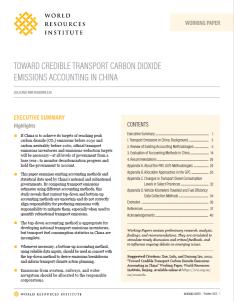Toward Credible Transport Carbon Dioxide Emissions Accounting in China
If China is to achieve its targets of reaching peak carbon dioxide emissions before 2030 and carbon neutrality before 2060, official transport emissions inventories and emissions-reduction targets will be necessary to monitor decarbonization progress and hold local governments to account.To help unify the transport carbon emissions accounting methodologies and improve statistical data collection for credible local transport emissions reporting, this study reviews the accounting methods and statistical data used globally and in China through a literature review and stakeholder interviews and proposes improvement recommendations.
China is developing a policy package to reach its targets of peaking carbon dioxide (CO2) emissions before 2030 and reaching carbon neutrality before 2060. However, at present, transport sector–wide emissions-reduction targets have not been set and official subnational transport emissions inventories are not required, which will make it difficult for different levels of government to understand the magnitude of transport emissions, identify major emissions sources, monitor decarbonization progress over time, and hold these governments to account.
To help unify the transport emissions accounting methodologies for China’s national and subnational governments and improve statistical data collection for credible transport emissions reporting, this study reviews the accounting methods and statistical data used globally and in China through a literature review and stakeholder interviews. It then employs six criteria, including data availability, estimation uncertainty, and policy relevance, among others, to evaluate existing emissions accounting/allocation methods in China.
To develop credible transport CO2 emissions inventories so that it can set sectoral emissions-reduction targets, monitor its decarbonization progress, and meet the Paris Agreement’s ETF (effective from 2024). This study recommends the following:
- Official transport emissions inventories should be required for subnational governments and be annually updated from a base year.
- The China-specific issue of incomplete transport fuel consumption statistics should be fixed. Comprehensive fuel sale statistics should be collected and verified with a quality assurance and quality control (QA/QC) procedure. The tabular structure of energy balances should be refined to subsectors and be consistent with the Enhanced Transparency Framework’s common reporting tables, which will become effective in 2024 (UNFCCC 2019). The frequency of fuel sales data collection should be increased, and enforcement of the regulations regarding illegal fuel stations, refineries, and fuel blenders should be tightened (MOFCOM 2020).
- Whenever necessary, a bottom-up method with reliable inputs should be used to derive emissions breakdowns and inform transport climate action planning. To this end, different levels of government need to periodically collect statistics such as vehicle kilometers travelled.
- Emissions from aviation, railways, and water navigation should be allocated to the responsible corporations because these businesses (especially state-owned enterprises) have more discretion and resources to mitigate their emissions than do subnational governments.
- Administrative safeguards should be put in place by updating relevant emissions accounting guidelines, developing data platforms, building capacities on data collection and inventory development, and establishing dedicated offices or personnel responsible for inventory development and validation.
Projects

Sustainable Mobility
Visit ProjectSustainable Mobility Project aims to contribute to the development of low-carbon transportation in China, and build a green, efficient, inclusive and resilient urban mobility system.
Part of Sustainable Cities
Low-carbon transport
Visit ProjectWe work with national and local partners to develop medium- and long-term transport decarbonization roadmaps, formulate near-term key emission-reduction solutions, and facilitate global knowledge sharing, to achieve the low-carbon transition of China’s transport sector while ensuring social equit
Part of Sustainable Cities

